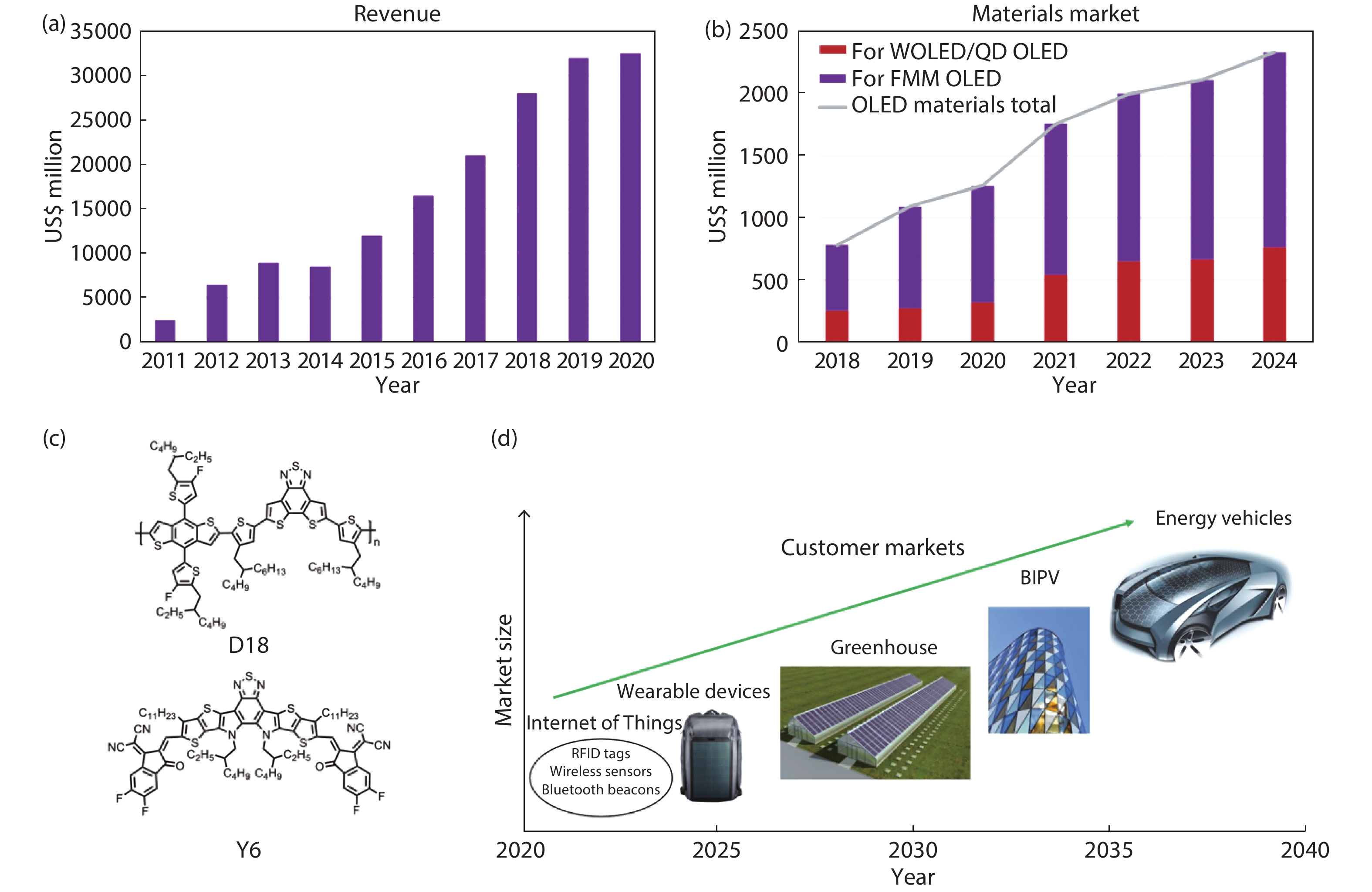| Citation: |
Xi Yang, Liming Ding. Organic semiconductors: commercialization and market[J]. Journal of Semiconductors, 2021, 42(9): 090201. doi: 10.1088/1674-4926/42/9/090201
****
X Yang, L M Ding, Organic semiconductors: commercialization and market[J]. J. Semicond., 2021, 42(9): 090201. doi: 10.1088/1674-4926/42/9/090201.
|
Organic semiconductors: commercialization and market
DOI: 10.1088/1674-4926/42/9/090201
More Information
-
References
[1] Yokota T, Fukuda K, Someya T. Recent progress of flexible image sensors for biomedical applications. Adv Mater, 2021, 33, 2004416 doi: 10.1002/adma.202004416[2] Tang C W, VanSlyke S A. Organic electroluminescent diodes. Appl Phys Lett, 1987, 51, 913 doi: 10.1063/1.98799[3] Chen H W, Lee J H, Lin B Y, et al. Liquid crystal display and organic light-emitting diode display: present status and future perspectives. Light Sci Appl, 2018, 7, 17168 doi: 10.1038/lsa.2017.168[4] [5] Kim J U, Park I S, Chan C Y, et al. Nanosecond-time-scale delayed fluorescence molecule for deep-blue OLEDs with small efficiency roll off. Nat Commun, 2020, 11, 1765 doi: 10.1038/s41467-020-15558-5[6] Chan C Y, Tanaka M, Lee Y T, et al. Stable pure-blue hyperfluorescence organic light-emitting diodes with high-efficiency and narrow emission. Nat Photonics, 2021, 15, 203 doi: 10.1038/s41566-020-00745-z[7] Ai X, Evans E W, Dong S Z, et al. Efficient radical-based light-emitting diodes with doublet emission. Nature, 2018, 563, 536 doi: 10.1038/s41586-018-0695-9[8] Yao Y, Shi C, Li G, et al. Effects of C70 derivative in low band gap polymer photovoltaic devices: Spectral complementation and morphology optimization. Appl Phys Lett, 2006, 89, 153507 doi: 10.1063/1.2361082[9] He Y, Chen H Y, Hou J H, et al. Indene-C60 bisadduct: A new acceptor for high-performance polymer solar cells. J Am Chem Soc, 2010, 132, 1377 doi: 10.1021/ja908602j[10] Yuan J, Zhang Y, Zhou L, et al. Single-junction organic solar cell with over 15% efficiency using fused-ring acceptor with electron-deficient core. Joule, 2019, 4, 1140 doi: 10.1016/j.joule.2019.01.004[11] Liu Q, Jiang Y, Jin K, et al. 18% Efficiency organic solar cells. Sci Bull, 2020, 65, 272 doi: 10.1016/j.scib.2020.01.001[12] Jin K, Xiao Z, Ding L. D18, an eximious solar polymer!. J Semicond, 2021, 42, 010502 doi: 10.1088/1674-4926/42/1/010502[13] Distler A, Brabec C J, Egelhaaf H J. Organic photovoltaic modules with new world record efficiencies. Prog Photovolt Res Appl, 2021, 29, 24 doi: 10.1002/pip.3336[14] Cui Y, Wang Y M, Bergqvist J, et al. Wide-gap non-fullerene acceptor enabling high-performance organic photovoltaic cells for indoor applications. Nat Energy, 2019, 4, 768 doi: 10.1038/s41560-019-0448-5[15] Zhen H Y, Li K, Zhang Y K, et al. Interfacial engineering of printable bottom back metal electrodes for full-solution processed flexible organic solar cells. J Semicond, 2018, 39, 014002 doi: 10.1088/1674-4926/39/1/014002[16] Sokolov A N, Tee B C K, Bettinger C J, et al. Chemical and engineering approaches to enable organic field-effect transistors for electronic skin applications. Acc Chem Res, 2012, 45, 361 doi: 10.1021/ar2001233[17] Yang D Z, Ma D G. Development of organic semiconductor photodetectors: from mechanism to applications. Adv Opt Mater, 2019, 7, 1800522 doi: 10.1002/adom.201800522 -
Proportional views






 DownLoad:
DownLoad:














